Mongoose
A mongoose is a small terrestrial carnivorous mammal belonging to the family Herpestidae. This family is currently split into two subfamilies, the Herpestinae and the Mungotinae. The Herpestinae comprises 23 living species that are native to southern Europe, Africa and Asia, whereas the Mungotinae comprises 11 species native to Africa.[2] The Herpestidae originated about 21.8 ± 3.6 million years ago in the Early Miocene and genetically diverged into two main genetic lineages between 19.1 and 18.5 ± 3.5 million years ago.[3]
| Mongoose | |
|---|---|
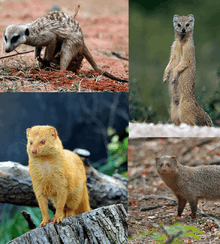 | |
| Top left: Meerkat Top right: Yellow mongoose Bottom left: Slender mongoose Bottom right: Indian gray mongoose | |
| Scientific classification | |
| Kingdom: | Animalia |
| Phylum: | Chordata |
| Class: | Mammalia |
| Order: | Carnivora |
| Suborder: | Feliformia |
| Family: | Herpestidae Bonaparte, 1845 |
| Type genus | |
| Herpestes | |
| Genera[1] | |
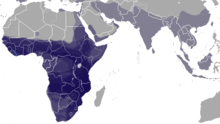 | |
| Synonyms[1] | |
|
List
| |
Etymology
The English word "mongoose" used to be spelled "mungoose" in the 18th and 19th centuries. The name is derived from names used in India for Herpestes species:[4][5][6][7] muṅgūs or maṅgūs in classical Hindi;[8] muṅgūsa in Marathi;[9] mungi in Telugu;[10] mungi, mungisi and munguli in Kannada.[11]
The form of the English name (since 1698) was altered to its "-goose" ending by folk etymology.[12] The plural form is "mongooses".[13]
Characteristics
Mongooses have long faces and bodies, small, rounded ears, short legs, and long, tapering tails. Most are brindled or grizzly; a few have strongly marked coats which bear a striking resemblance to mustelids. Their nonretractile claws are used primarily for digging. Mongooses, much like goats, have narrow, ovular pupils. Most species have a large anal scent gland, used for territorial marking and signaling reproductive status. The dental formula of mongooses is 3.1.3–4.1–23.1.3–4.1–2. They range from 24 to 58 cm (9.4 to 22.8 in) in head-to-body length, excluding the tail. In weight, they range from 320 g (11 oz) to 5 kg (11 lb).[14]
Mongooses are one of at least four known mammalian taxa with mutations in the nicotinic acetylcholine receptor that protect against snake venom.[15] Their modified receptors prevent the snake venom α-neurotoxin from binding. These represent four separate, independent mutations. In the mongoose, this change is effected uniquely, by glycosylation.[16]
Taxonomy
Herpestina was a scientific name proposed by Charles Lucien Bonaparte in 1845 who considered the mongooses a subfamily of the Viverridae.[17] In 1864, John Edward Gray classified the mongooses into three subfamilies: Galiidinae, Herpestinae and Mungotinae.[18] This grouping was supported by Reginald Innes Pocock in 1919 who referred to the family as "Mungotidae".[19]
Genetic research based on nuclear and mitochondrial DNA analyses revealed that the galidiines are more closely related to Madagascar carnivores, including the fossa and Malagasy civet.[20][21] Galiidinae is presently considered a subfamily of Eupleridae.[22]
| Subfamily | Genus | Species | Image of type species |
|---|---|---|---|
| Herpestinae | |||
| Herpestes Illiger, 1811[23] |
|
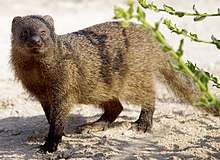 | |
| Atilax Cuvier, 1826[32] | Marsh mongoose (A. paludinosus) Cuvier, 1829[33] | .jpg) | |
| Cynictis Ogilby, 1833[34] | Yellow mongoose (C. penicillata) (Cuvier, 1829)[33] | 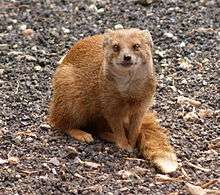 | |
| Ichneumia Geoffroy Saint-Hilaire, 1837 | White-tailed mongoose (I. albicauda) (Cuvier, 1829)[33] | %2C_crop.jpg) | |
| Bdeogale Peters, 1850[35] |
|
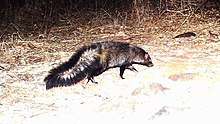 | |
| Galerella Gray, 1864 |
|
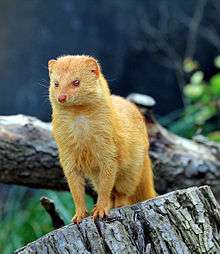 | |
| Rhynchogale Thomas, 1894 | Meller's mongoose (R. melleri) Gray, 1865 |  | |
| Paracynictis Pocock, 1916 | Selous's mongoose (P. selousi) (de Winton, 1896) | 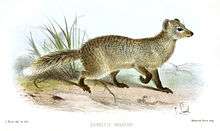 | |
| Mungotinae | Mungos E. Geoffroy Saint-Hilaire & F. Cuvier, 1795[42] |
|
.jpg) |
| Suricata Desmarest, 1804[45] | Meerkat (S. suricatta) (Schreber, 1776)[46] | _(32993685706).jpg) | |
| Crossarchus Cuvier, 1825 |
|
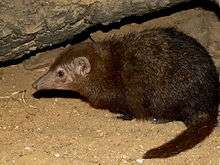 | |
| Helogale Gray, 1861 |
|
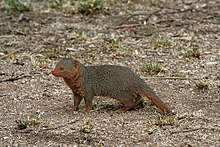 | |
| Dologale Thomas, 1920 | Pousargues's mongoose (D. dybowskii) Pousargues, 1894[47] | 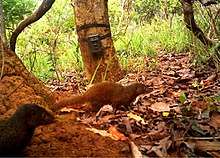 | |
| Liberiictis Hayman, 1958 | Liberian mongoose (L. kuhni) Hayman, 1958 |
Phylogenetic relationships
In 1989, zoologist W. Christopher Wozencraft noted that while the phylogenetic relationships in Mungotinae were obscure, studies in the latter part of 20th century supported two monophyletic clades in Herpestinae: one consisting of Atilax and Herpestes, and the other comprising Bdeogale, Ichneumia and Rhynchogale.[48] Like other feliformian carnivorans, mongooses descended from the viverravines, which were civet- or genet-like mammals.
The phylogenetic relationships of Herpestidae are shown in the following cladogram:[49][3]
| Herpestidae |
| ||||||||||||||||||||||||||||||||||||||||||||||||||||||||||||||||||||||||||||||||||||||||||||||||||||||||||||||||||||||||||||||||||||||||||||||||||||||||||||||||||||||||||||||||||||||||||
Extinct species
Leptoplesictis Major, 1903[50]
- †L. atavus Beaumont, 1973
- †L. aurelianensis (Schlosser, 1888)
- †L. filholi Gaillard, 1899
- †L. mbitensis Schmidt-Kittler, 1987
- †L. namibiensis Morales et al., 2008
- †L. peignei, Grohé et al., 2020
- †L. rangwai Schmidt-Kittler, 1987
- †L. senutae Morales et al., 2008
Behaviour and ecology
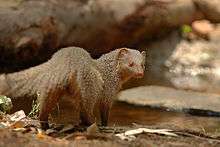
Mongooses are largely terrestrial. The Egyptian mongoose (Herpestes ichneumon) has been observed in pairs and groups of up to five individuals.[51]
Diet
Mongooses mostly feed on insects, crabs, earthworms, lizards, birds, and rodents. However, they also eat eggs and carrion.[52]
The Indian gray mongoose and others are well known for their ability to fight and kill venomous snakes, particularly cobras. They are adept at such tasks due to their agility, thick coats, and specialized acetylcholine receptors that render them resistant or immune to snake venom.[53] However, they typically avoid the cobra and have no particular affinity for consuming its meat.[54]
Some species can learn simple tricks. They can be semi-domesticated and are kept as pets to control vermin.[55] However, they can be more destructive than desired. When imported into the West Indies to kill rats, they destroyed most of the small, ground-based fauna. For this reason, it is illegal to import most species of mongooses into the United States,[56] Australia, and other countries. Mongooses were introduced to Hawaii in 1883 and have had a significant adverse effect on native species.[57]
Reproduction
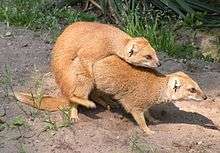
The mongoose emits a high-pitched noise, commonly known as giggling, when it mates. Giggling is also heard during courtship.[58] Communities of female banded mongooses (Mungos mungo) synchronize their whelping to the same day to deter infanticide by dominant females.
Lifespan
It is not yet known how long a mongoose lives in its natural habitat; however, it is known that the average lifespan in captivity is twenty years.[59]
Relationship with humans
In ancient Mesopotamia, mongooses were sacred to the deity Ningilin, who was conflated with Ningirima, a deity of magic who was invoked for protection against serpents. According to a Babylonian popular saying, when a mouse fled from a mongoose into a serpent's hole, it announced, "I bring you greetings from the snake-charmer!" A creature resembling a mongoose also appears in Old Babylonian glyptic art, but its significance is not known.[60]
According to Greek historian Diodorus Siculus (1.35 & 1.87), Egyptians venerated native mongooses (Herpestes ichneumon) for their ability to handle venomous snakes and for their occasional diet of crocodile eggs. The Buddhist god of wealth Vaiśravaṇa, or Dzambala for Tibetans, is frequently depicted holding a mongoose that is spitting jewels from its mouth.[61] The Hindu god of wealth, Kubera (being the son of Vishrava ("Fame"), Kubera is also called Vaisravana), is often portrayed holding a mongoose in his left hand, hence the sight of a mongoose is considered lucky by some.[62]
All mongoose species, except for Suricata suricatta, are classed as a "prohibited new organism" under New Zealand's Hazardous Substances and New Organisms Act 1996, preventing them from being imported into the country.[63]
Mongooses are a common spectacle at roadside shows in Pakistan. Snake charmers keep mongooses for mock fights with snakes. This practice is looked at as unethical and cruel across the rest of the world.
On Okinawa (where mongooses were misguidedly brought in to control the local habu snake), mongoose fights with these highly venomous snakes (Ovophis okinavensis and Trimeresurus flavoviridis) in a closed perimeter were presented as spectator events at such parks as Okinawa World; however, due to pressure from animal rights activists, the spectacle is less common today.[64]
In popular culture
A well-known fictional mongoose is Rikki-Tikki-Tavi, who appears in a short story of the same title in The Jungle Book (1894) by Rudyard Kipling. In this tale set in India, the young mongoose saves his family from a krait and from Nag and Nagaina, two cobras. The story was later made into several films and a song by Donovan, among other references. A mongoose is also featured in Bram Stoker's novel The Lair of the White Worm. The main character, Adam Salton, purchases one to independently hunt snakes. Another mongoose features in the denouement of the Sherlock Holmes story "The Adventure of the Crooked Man", by Sir Arthur Conan Doyle. The Indian Tamil devotional film Padai Veetu Amman shows Tamil actor Vinu Chakravarthy changing himself into a mongoose by using his evil tantric mantra, to fight with goddess Amman. However, the mongoose finally dies in the hands of the goddess.
The mongoose is a prohibited animal in the United States. However, the 1962 case of "Mr. Magoo" became an exception. It was brought to Duluth, Minnesota by a merchant seaman and faced being euthanized. A public campaign to save it resulted in the intervention of Secretary of the Interior Stewart Udall, who exempted Magoo from the regulations. Magoo lived on display as the most popular attraction of the Lake Superior Zoo, dying of old age in 1968.[65]
Pablo Neruda had a pet mongoose named Kiria while he lived in Colombo. Kiria had the habit of following the poet everywhere. However, after Neruda moved to Batavia, Kiria disappeared and was never seen again.[66]
References
- Wozencraft, W.C. (2005). "Family Herpestidae". In Wilson, D.E.; Reeder, D.M (eds.). Mammal Species of the World: A Taxonomic and Geographic Reference (3rd ed.). Johns Hopkins University Press. pp. 562–571. ISBN 978-0-8018-8221-0. OCLC 62265494.
- Gilchrist, J.S.; Jennings, A.P.; Veron, G. & Cavallini, P. (2009). "Family Herpestidae (Mongooses)". In Wilson, D. E. & Mittermeier, R. A. (eds.). Handbook of the Mammals of the World. Volume 1. Carnivores. Barcelona: Lynx Edicions. p. 311. ISBN 978-84-96553-49-1.
- Patou, M.; Mclenachan, P.A.; Morley, C.G.; Couloux, A.; Jennings, A.P.; Veron, G. (2009). "Molecular phylogeny of the Herpestidae (Mammalia, Carnivora) with a special emphasis on the Asian Herpestes". Molecular Phylogenetics and Evolution. 53 (1): 69–80. doi:10.1016/j.ympev.2009.05.038. PMID 19520178.
- Valentini, M.B. & Major, J.D. (1714). "Viverra Indica grysea. Mungos". Museum museorum, oder, Vollständige Schau Bühne aller Materialien und Specereyen. 2 Appendix IX. Franckfurt am Mayn: Johann David Zunners Sel. Erben, und Johann Adam Jungen. p. 24.
- Jerdon, T.C. (1874). "127. Herpestes griseus". The mammals of India; a natural history of all the animals known to inhabit continental India. London: J. Wheldon. pp. 132–134.
- Sterndale, R.A. (1884). "Herpestidae. The Ichneumon or Mungoose Family". Natural history of the Mammalia of India and Ceylon. Calcutta: Thacker & Spink. pp. 222–228.
- Lydekker, R. (1894). "XIII. The Mungooses. Genus Herpestes". A hand-book to the Carnivora. Part 1: Cats, civets, and mungooses. London: Edward Lloyd Limited. pp. 244–269.
- Platts, J.T. (1884). "منگوس मुंगूस muṅgūs, or मंगूस maṅgūs. The Mongoose, or ichneumon, Viverra ichneumon". A dictionary of Urdu, classical Hindi, and English. London: W. H. Allen & Co. p. 1081.
- Molesworth, J. T. (1857). "मुंगूस muṅgūsa, Bengal Mungoose, Viverra Ichneumon, or Herpesteus Griseus". A dictionary, Marathi and English (Second, revised and enlarged ed.). Bombay: Printed for Government at the Bombay Education Society's Press. p. 384.
- Brown, C.P. (1903). "ముంగి or ముంగిస mungi. The ichneumon or mongoose, a kind of weasel. Viverra ichneumon". A Telugu-English dictionary (New, thoroughly revised and brought up to date second ed.). Madras: Promoting Christian Knowledge. p. 997.
- Reeve, W. & Sanderson, D. (1858). "ಮುಂಗಿ, ಮುಂಗಿಸಿ, ಮುಂಗುಲಿ". A dictionary, Canarese and English (Revised, corrected and enlarged ed.). Bangalore: Wesleyan Mission Press. p. 787.
- Forsyth, M. (2012). "Folk etymology". The Etymologicon: A Circular Stroll Through the Hidden Connections of the English Language. Penguin Books. p. 77. ISBN 9781101611760.
- Hinton, H. E. & Dunn, A. M. S. (1967). "Preface". Mongooses: Their Natural History and Behaviour. Berkeley: University of California Press. p. v. OCLC 1975837.
- Macdonald, D., ed. (2009). The Encyclopedia of Mammals. Oxford: Oxford University Press. p. 660. ISBN 978-0-19-956799-7.
- Barchan, D.; Kachalsky, S., Neumann, D., Vogel, Z., Ovadia, M., Kochva, E. and Fuchs, S. (1992). "How the mongoose can fight the snake: the binding site of the mongoose acetylcholine receptor" (PDF). Proceedings of the National Academy of Sciences. 89 (16): 7717–7721. doi:10.1073/pnas.89.16.7717. PMC 49782. PMID 1380164.CS1 maint: multiple names: authors list (link)
- Drabeck, D. H.; Dean, A. M.; Jansa, S. A. (2015). "Why the honey badger don't care: Convergent evolution of venom-targeted nicotinic acetylcholine receptors in mammals that survive venomous snake bites". Toxicon. 99: 68–72. doi:10.1016/j.toxicon.2015.03.007. PMID 25796346.
- Bonaparte, C. L. (1845). "Fam. VII. Viverridae". Catalogo Methodico dei Mammiferi Europei. Milan, Italy: L. di Giacomo Pirola. p. 8.
- Gray, J.E. (1865). "A revision of the genera and species of viverrine animals (Viverridae) founded on the collection in the British Museum". Proceedings of the Zoological Society of London: 502–579.
- Pocock, R. I. (1919). "The classification of mongooses (Mungotidae)". The Annals and Magazine of Natural History. 9 (3): 515–524. doi:10.1080/00222931908673851.
- Yoder, A. D.; Burns, M. M.; Zehr, S.; Delefosse, T.; Veron, G.; Goodman, S. M.; Flynn, J. J. (2003). "Single origin of Malagasy carnivora from an African ancestor". Nature. 421 (6924): 434–437. doi:10.1038/nature01303. PMID 12610623.
- Flynn, J. J.; Finarelli, J.; Zehr, S.; Hsu, J.; Nedbal, M. (2005). "Molecular phylogeny of the Carnivora (Mammalia): Assessing the Impact of Increased sampling on resolving enigmatic relationships". Systematic Biology. 54 (2): 317–337. doi:10.1080/10635150590923326. PMID 16012099.
- Wilson, D.E.; Reeder, D.M., eds. (2005). Mammal Species of the World: A Taxonomic and Geographic Reference (3rd ed.). Johns Hopkins University Press. ISBN 978-0-8018-8221-0. OCLC 62265494.
- Illiger, C. (1815). "Überblick der Säugethiere nach ihrer Verteilung über die Welttheile". Abhandlungen der Königlichen Preußischen Akademie der Wissenschaften zu Berlin. 1804−1811: 39−159.
- Linnaeus, Carl (1758). "Viverra ichneumon". Caroli Linnæi Systema naturæ per regna tria naturæ, secundum classes, ordines, genera, species, cum characteribus, differentiis, synonymis, locis. Tomus I (decima, reformata ed.). Holmiae: Laurentius Salvius. p. 41. (in Latin)
- Geoffroy Saint-Hilaire, É. (1817). "De l'Ichneumon. Ichneumon pharaon". In Jomard, E. F. (ed.). Description de l'Égypte, ou, Recueil des observations et des recherches qui ont été faites en Égypte pendant l'éxpédition de l'armée française. Tome II. Paris: Commission des Sciences et Arts d'Egypte. pp. 137–144.
- Bennett, E. T. (1835). "Remarks on some Mammalia from Travancore, including a New Species of Herpestes". Proceedings of the Zoological Society of London. III: 66–67.
- Hodgson, B. H. (1836). "Synoptical description of sundry new animals, enumerated in the Catalogue of Nepalese Mammals". Journal of the Asiatic Society of Bengal. 5: 231–238.
- Gray, J. E. (1837). "Description of some or little known Mammalia, principally in the British Mueum Collection". The Magazine of Natural History and Journal of Zoology, Botany, Mineralogy, Geology and Meteorology. I (November): 577–587.
- Waterhouse, G.R. (1838). "On two new species of Mammalia, from the Society's collection, belonging to the genera Gerbillus and Herpestes". Proceedings of the Zoological Society of London. VI: 55–56.
- Gray, J.E. (1846). "New species of Mammalia". The Annals and Magazine of Natural History; Zoology, Botany, and Geology. 18 (118): 211–212.
- de Winton, W. E. (1901). "Description of a New Mongoose from West Africa". Bulletin of the Liverpool Museums under the City Council. 3 (2): 35–37.
- Cuvier, F. G. (1826). "Vansire". In E. Geoffroy Saint-Hilaire; F. G. Cuvier (eds.). Histoire Naturelle des Mammifères : avec des figures originales, coloriées, dessinées d'aprèsdes animaux vivans. Tome 5. Paris: A. Belin. p. LIV.CS1 maint: uses authors parameter (link)
- Cuvier, G. (1829). "Les Mangoustes. Cuv. (Herpestes, Illiger)". Le règne animal distribué d'après son organisation, pour servir de base à l'histoire naturelle des animaux et d'introduction à l'anatomie comparée. Paris: Chez Déterville. pp. 157–158.
- Ogilby, W. (1833). "Characters of a new Genus of carnivorous Mammalia from the collection of Mr. Steedman". Proceedings of the Zoological Society of London (Part 1): 48–49.
- Peters, W. (1850). "Bdeogale". Sitzungsberichte der Gesellschaft Naturforschender Freunde zu Berlin: 94.
- Peters, W. (1852). "Mittheilung über die in Mossambique beobachteten Mangusten". Verhandlungen der Königlich Preussischen Akademie der Wissenschaften zu Berlin: 81–82.
- Pucheran, J.P. (1855). "Les Mammifères de la côte occidental d'Afrique". Revue et magasin de zoologie pure et appliquée. 2. 7: 111.
- Thomas, O. (1894). "On a new African Genus of Mustelidae". The annals and magazine of natural history : zoology, botany, and geology. 6. 13 (78): 522–524.
- Heller, E. (1914). "New antelopes and carnivores from British East Africa". Smithsonian miscellaneous collections. 61 (2240): 1–15.
- Foley, C. & Do Linh San, E. (2016). "Bdeogale omnivora". IUCN Red List of Threatened Species. 2016: e.T136686A45221619.
- Wagner, J.A. (1839). "Über die Verwandtschafts-Verhältnisse der Pharaonsratte". Gelehrte Anzeigen der Königlich Bayerischen Akademie der Wissenschaften zu München. 9 (183): 425–429.
- Geoffroy, E. & Cuvier, F. (1795). "Mémoire sur une nouvelle division des Mammifères, et sur Ies principes qui doivent servir de base dans cette sorte de travail, lu à la société d'Histoire naturelle, le premier floréal de l'an troisième". In Millin; Noel & Warens (eds.). Magasin Encyclopédique : ou journal des sciences, des lettres et des arts. Tome second. Paris: I'lmprimerie du Magazin Encyclopédique. pp. 164–189.
- Gmelin, J. F. (1788). "Viverra mungo". Caroli a Linné, Systema naturae per regna tria naturae, secundum classes, ordines, genera, species, cum characteribus, differentiis, synonymis, locis. I (13th aucta, reformata ed.). Lipsiae: Georg Emanuel Beer. p. 84–85.
- Ogilby, W. (1835). "Descriptions of Mammalia and Birds from the Gambia". Proceedings of the Zoological Society of London. Part III: 97–105.
- Desmarest, A. G. (1804). "Genre Surikate, Suricata Nob.". In Deterville, J. F. P. (ed.). Nouveau dictionnaire d'histoire naturelle appliquée aux arts : principalement à l'agriculture et à l'économie rurale et domestique. 24. Paris: Deterville. p. 15.
- Schreber, J. C. D. (1776). "Viverra suricata". Die Säugethiere in Abbildungen nach der Natur, mit Beschreibungen. Erlangen: Expedition des Schreber'schen Säugthier- und des Esper'schen Schmetterlingswerkes. p. CVII.
- de Pousargues, E. (1894). "Description d'une nouvelle espèce de mammifère du genre Crossarchus et considérations sur la répartition géographique des crossarques rayés". Nouvelles Archives du Muséum d'Histoire Naturelle. 3. 6: 121–134.
- Veron, G.; Colyn, M.; Dunham, A.E.; Taylor, P.; Gaubert, P. (2004). "Molecular systematics and origin of sociality in mongooses (Herpestidae, Carnivora)". Molecular Phylogenetics and Evolution. 30 (3): 582–598. doi:10.1016/S1055-7903(03)00229-X. PMID 15012940.
- Barycka, E. (2005). "Evolution and systematics of the feliform Carnivora". Mammalian Biology. 72 (5): 257–282. doi:10.1016/j.mambio.2006.10.011.
- Morales, J., Pickford, M. and Salesa, M.J. (2008). "Creodonta and Carnivora from the Early Miocene of the Northern Sperrgebiet, Namibia". Memoir of the Geological Survey of Namibia. 20: 291–310.CS1 maint: uses authors parameter (link)
- Palomares, F.; Delibes, M. (1993). "Social organization in the Egyptian mongoose: group size, spatial behaviour and inter-individual contacts in adults". Animal Behaviour. 45 (5): 917–925. doi:10.1006/anbe.1993.1111.
- Cronk, N. E.; Pillay, N. (2018). "Food choice and feeding on carrion in two African mongoose species in an urban environment". Acta Ethologica. 21 (2): 127–136. doi:10.1007/s10211-018-0291-x.
- Barchan, D.; Kachalsky, S.; Neumann, D.; Vogel, Z.; Ovadia, M.; Kochva, E.; Fuchs, S. (1992). "How the Mongoose Defeats the Snake". Proceedings of the National Academy of Sciences. 89 (16): 7717–7721. doi:10.1073/pnas.89.16.7717. PMC 49782. PMID 1380164.
- Mondadori, A., ed. (1988). Great Book of the Animal Kingdom. New York: Arch Cape Press. p. 301.
- Sherman, D. M. (2007). Tending Animals in the Global Village: A Guide to International Veterinary Medicine. John Wiley & Sons. ISBN 9780470292105.
- "Animals whose importation is banned under the Lacey Act". Archived from the original on 25 June 2006. Retrieved 12 April 2006.
- "Star Bulletin: Traps set to catch mongoose on Kauai". Retrieved 12 April 2006.
- Poushali Ganguly. "Mongoose Facts". Buzzle. Archived from the original on 20 August 2016. Retrieved 17 February 2009.
- "Mongoose – Herpestidae". National Geographic. Retrieved 13 August 2016.
- Black, J.; Green, A. (1992). Gods, Demons and Symbols of Ancient Mesopotamia: An Illustrated Dictionary. The British Museum Press. p. 132. ISBN 0-7141-1705-6.CS1 maint: ref=harv (link)
- "Symbolism of Mongoose in Art". indology list indology.info.
- "Kuber Golden Temple". kubergoldentemple.org. Archived from the original on 25 April 2017. Retrieved 10 May 2015.
- "Hazardous Substances and New Organisms Act 2003 - Schedule 2 Prohibited new organisms". New Zealand Government. Retrieved 26 January 2012.
- Charles, Bill. "Okinawa World Presents Midsummer Thrills." Japan Update. 24 August 2012. http://www.japanupdate.com/archive/index.php?id=12558.
- Krueger, A. 2010. Remembering Duluth's famous mongoose, Mr. Magoo at the Duluth News Tribune (via archive.org); retrieved 27 July 2014.
- Neruda, P. (1977). Memoirs. New York: Farrar, Straus and Giroux.
Further reading
- Rasa, A. (1986). Mongoose Watch: A Family Observed. Garden City, N.Y.: Anchor Press, Doubleday & Co. ISBN 9780385231756. OCLC 12664019.
- Lodrick, Derygk O. "Man and Mongoose in Indian Culture." Anthropos 77, no. 1/2 (1982): 191-214. Accessed June 23, 2020. www.jstor.org/stable/40460438.
External links
| Wikispecies has information related to Herpestidae |
| Wikimedia Commons has media related to Herpestidae. |
- . Encyclopædia Britannica (11th ed.). 1911.